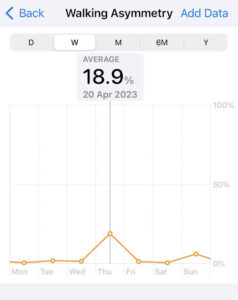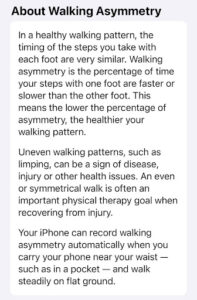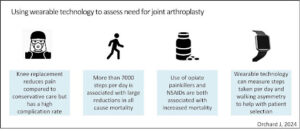Keywords
Wearable technology, exercise medicine, joint arthroplasty
Introduction
In 2015, I wrote a BJSM Blog on “Deciding when it is time to have a knee replacement”,[1] arguing for a shift away from using structural markers to assess need for knee replacement (such as X-ray and MRI) to objective functional markers. I suggested a cut off point of 7000 steps per day; that patients who clearly could not reach this level due to severity of knee pain were the ones who were most in need of knee replacement.
Since the 2015 non-blinded RCT, [2] there hasn’t been any further RCTs on knee replacement (vs conservative), but a recent cohort study also showed better pain outcomes after surgery.[3] There has also been a huge amount of data showing an association between walking 7000 steps per day (or more) and reductions in all-cause mortality.[4, 5] Although most people elect to have joint replacement aiming to reduce pain levels, from an all-cause mortality viewpoint, it is even more important to prioritise the ability to allow people to complete the (necessary) amount of walking per day. It is also important to note that joint replacements are still somewhat risky procedures, leading to more medical complications than conservative care[2] and therefore should not be undertaken lightly.
Hip versus knee replacements
Although we don’t have an RCT to compare hip replacement to an alternative, in the real-world hip replacements are considered to be equal to if not superior to knee replacements in terms of outcomes. Certainly it is more common to return to higher level sport after hip arthroplasty than it is after knee arthroplasty. Two high profile examples are Bo Jackson (Ex-NFL player who returned to play Major League Baseball) and Andy Murray (tennis). It is not rare to see patients who have had successful hip replacements be able to return to high level triathlon activities, for example, and even complete marathons.[6] However, all joint replacements are associated with risks of serious complications. Three high profile Australians have recently died within weeks of having had hip replacements[7, 8] even though this is considered a rare event.[9]
As a general rule, the efficacy of arthroplasty relates to the amount and quality of bone available to fix the prosthesis in place. This means that hip and knee replacements perform better than ankle replacements and exercising individuals tend to do better than sedentary individuals. Short-term results will be better in younger, healthier patients (such as Andy Murray) with the concerns in this group being the risk associated with revision procedures decades down the track.
Other considerations relating to quality of daily steps
As a raw score, daily step counts of 7000 or over are associated with far superior health outcomes. [4, 5] Anyone doing fewer than, say, 5000-6000 steps per day should be encouraged to increase to around 6000-7000 steps per day to achieve the health benefits associated with moderate level walking.[10] There are a few caveats to this advice, however, which are regular features of Exercise Medicine consultations:
- Using daily opiate painkillers or NSAIDs to allow greater amounts of daily walking can be “robbing Peter to pay Paul”.[11] Increasing from 4000 steps per day to 7000 steps per day might be associated with a 30% reduction in mortality, but taking a daily NSAID is often associated with a 30% increase in mortality.[12] Exercise is very important, but it is equally important to avoid taking NSAIDs if you are considering exercise as a way to improve survival. The mortality statistics associated with daily use of opiate painkillers are even more dire than NSAIDs.
- Exercise and opiate painkillers have almost diametrically opposite effects in the short and long term.[13] Exercise can have an immediate effect of increasing musculoskeletal pain, but it strongly reduces pain in the longer term. Opiate painkillers reduce pain in the short term but in most cases increase pain in the long term (or require dose increase to maintain successful pain relief, but in doing so expose the patient to ever-increasing side effects).
- The key to successful exercise increase in the background of pain is to monitor and make the increase very gradual.[14] This means counting steps (using either a mobile phone that is always carried or a wrist wearable that is always on, or a combination of both) every day and setting targets for gradual increase. A conservative level of upgrade would be 1000 steps per day increase each month, or at low levels of steps 500 steps per day increase each month.
Use of walking asymmetry as an additional metric
Modern wearable devices and Apps (such as Apple Health, Figures 1 and 2) can measure walking asymmetry and this is a great additional measure to help assess how badly an arthritic joint is affecting someone. All health professionals appreciate that there are some stoical individuals who are in a lot of pain but won’t admit it to anyone (including themselves), whereas there are others who have poor pain tolerance and tendency towards addiction who will express high levels of pain in order to seek ready access to painkillers. Trying to second guess whether a patient is over or under reporting pain through the history is difficult. Walking asymmetry (and variations/worsening of this metric) can tell whether patient is trying to avoid generating equal force from each leg because one is more painful than the other. Someone who is doing 8000 steps per day (which is a healthy amount) but with high levels of walking asymmetry (e.g. greater than 20%) may be heading for trouble with an adequate walking amount but limping a lot. Someone who is “only” doing 5000 steps per day but with hardly any walking asymmetry (e.g. less than 5%) can be encouraged to gradually build up to higher step levels, as if walking is very steady they probably should have the capacity to do higher levels if they have the patience to build up gradually.


Figures 1 and 2 – Walking Asymmetry sample output and explanation on the Apple Health App
Graphical abstract

AUTHOR:
John Orchard is an Australian sport and exercise physician. He has no conflicts to declare other than treating knee osteoarthritis patients in clinic. His views are personal and not necessarily representative of organisations he is affiliated with.
REFERENCES
- Orchard J. Assessing when it’s the right time to have a knee replacement. https://blogs.bmj.com/bjsm/2015/12/01/assessing-when-its-the-right-time-to-have-a-knee-replacement/: BJSM Blog; 2015.
- Skou ST, Roos EM, Laursen MB, et al. A Randomized, Controlled Trial of Total Knee Replacement. New England Journal of Medicine. 2015; 373(17):1597-1606.
- Young JJ, Zywiel MG, Skou ST, et al. Total knee arthroplasty versus education and exercise for knee osteoarthritis: a propensity-matched analysis. Arthritis care & research. n/a(n/a).
- Kraus WE, Janz KF, Powell KE, et al. Daily Step Counts for Measuring Physical Activity Exposure and Its Relation to Health. Med Sci Sports Exerc. 2019; 51(6):1206-1212.
- Lee IM, Shiroma EJ, Kamada M, Bassett DR, Matthews CE, Buring JE. Association of Step Volume and Intensity With All-Cause Mortality in Older Women. JAMA Intern Med. 2019; 179(8):1105-1112.
- IBJI. Running After Hip Replacement: Yes, It Can Be Done and This Patient Ran a Marathon. https://www.ibji.com/blog/patient-stories/running-after-hip-replacement-yes-it-can-be-done-and-this-patient-ran-a-marathon/2022.
- Pawle F. The ‘hidden danger’ lurking in routine surgery as the sudden deaths of Cardinal George Pell and singing legend Renee Geyer are blamed on complications linked to simple procedure. The Daily Mail. https://www.dailymail.co.uk/news/article-11646879/George-Pell-Renee-Geyer-cause-death-die-hip-replacement-surgery-complications.html2023.
- Singh A. Dame Edna star Barry Humphries taken to hospital in ‘serious condition’. The Telegraph. https://www.telegraph.co.uk/news/2023/04/19/dame-edna-barry-humphries-hospital-serious-condition-sydney/2023.
- Mannix L. Hip replacement a safe procedure and deaths extremely rare. Sydney Morning Herald. https://www.smh.com.au/national/hip-replacement-a-safe-procedure-and-deaths-extremely-rare-20230111-p5cbu1.html2023.
- Orchard JW. Using technology to measure daily and weekly movement patterns in exercise medicine patients. Br J Sports Med. 2017; 51(18):1317-1318.
- Liu Q, Niu J, Li H, et al. Knee Symptomatic Osteoarthritis, Walking Disability, NSAIDs Use and All-cause Mortality: Population-based Wuchuan Osteoarthritis Study. Sci Rep. 2017; 7(1):3309.
- Kerr SJ, Rowett DS, Sayer GP, Whicker SD, Saltman DC, Mant A. All-cause mortality of elderly Australian veterans using COX-2 selective or non-selective NSAIDs: a longitudinal study. Br J Clin Pharmacol. 2011; 71(6):936-942.
- Orchard J. The fight between medicine and scepticism needs to be resolved by evidence: Book reviews. JSAMS Plus. 2023; 2:100042, https://doi.org/100010.101016/j.jsampl.102023.100042.
- Orchard JW. Prescribing and dosing exercise in primary care. Aust J Gen Pract. 2020; 49(4):182-186.